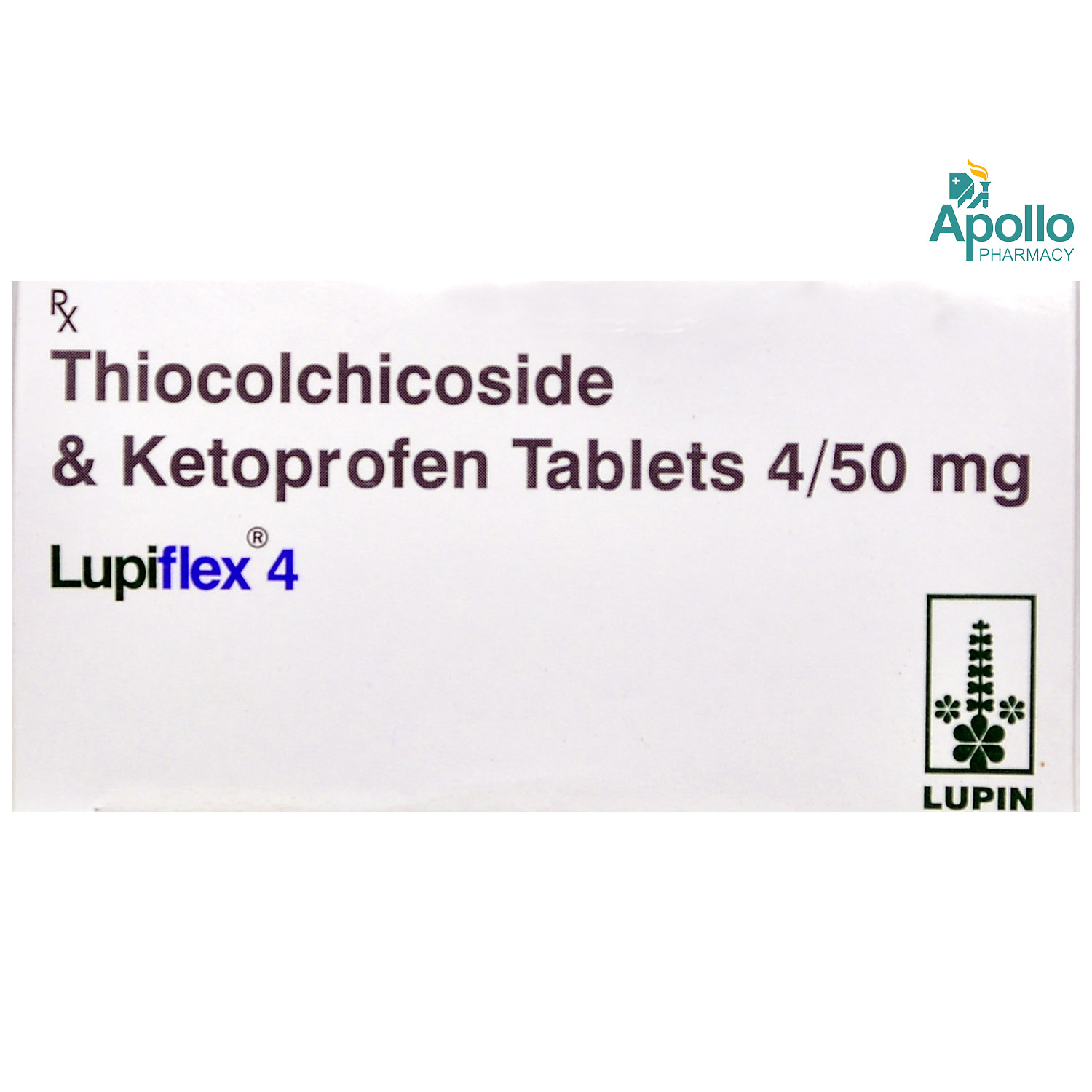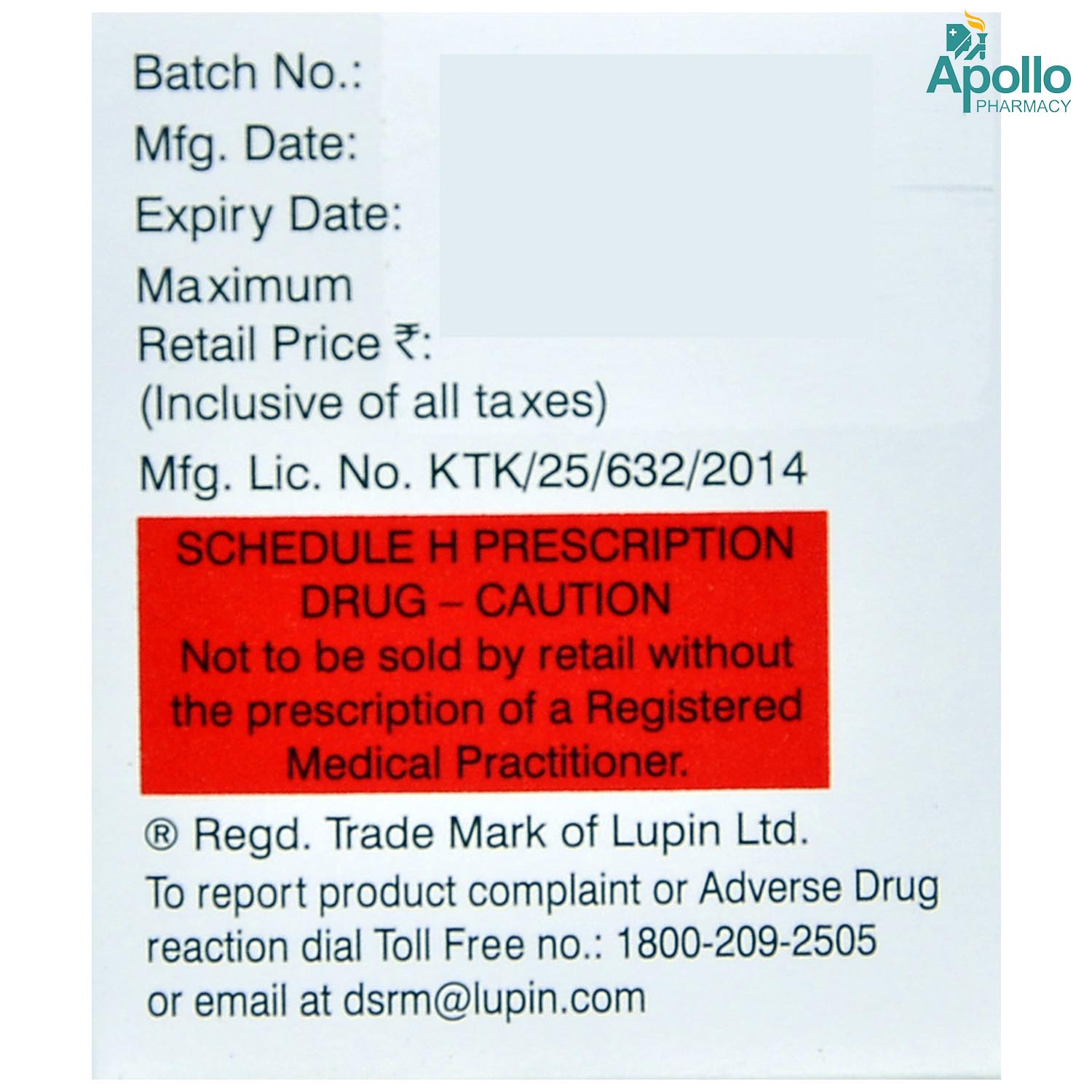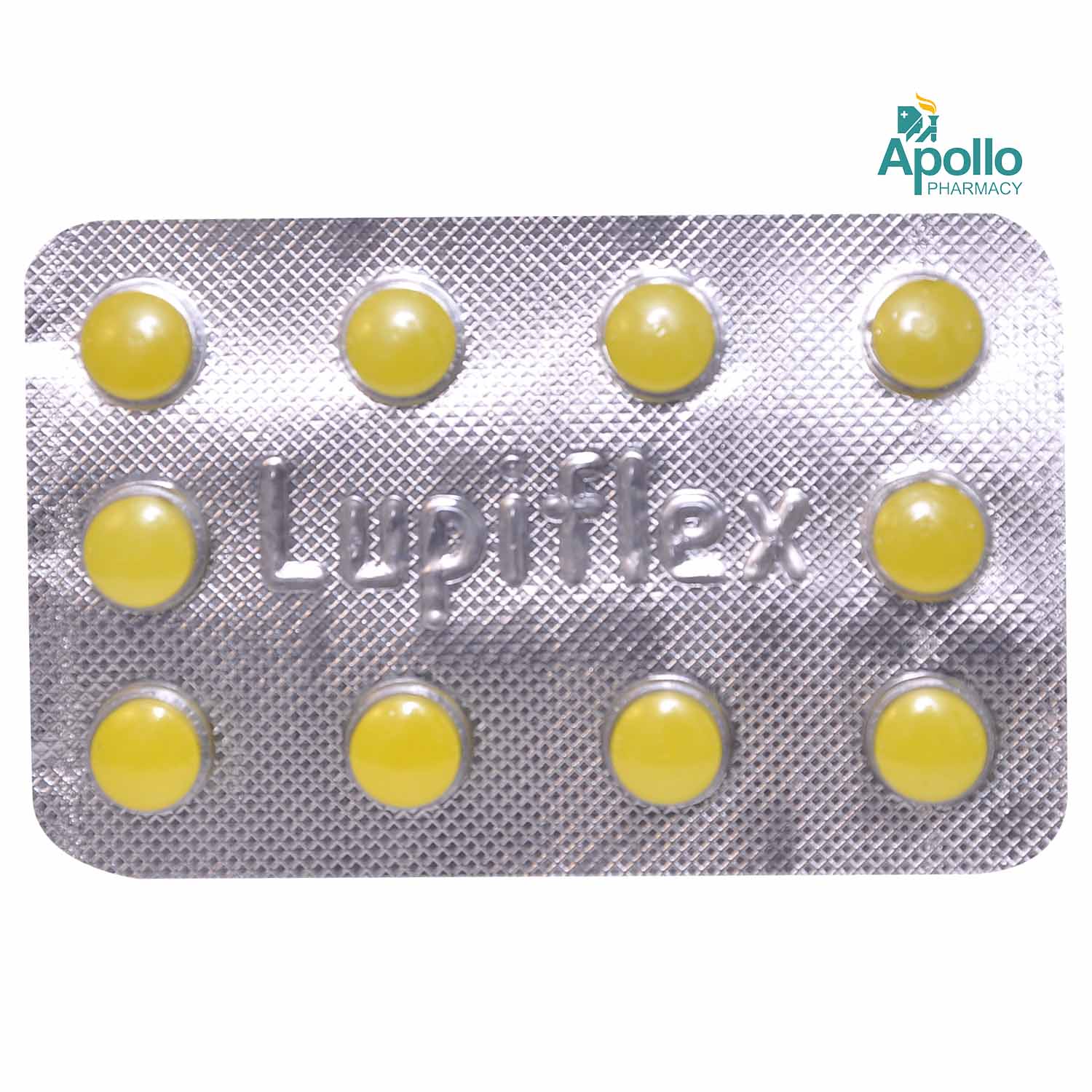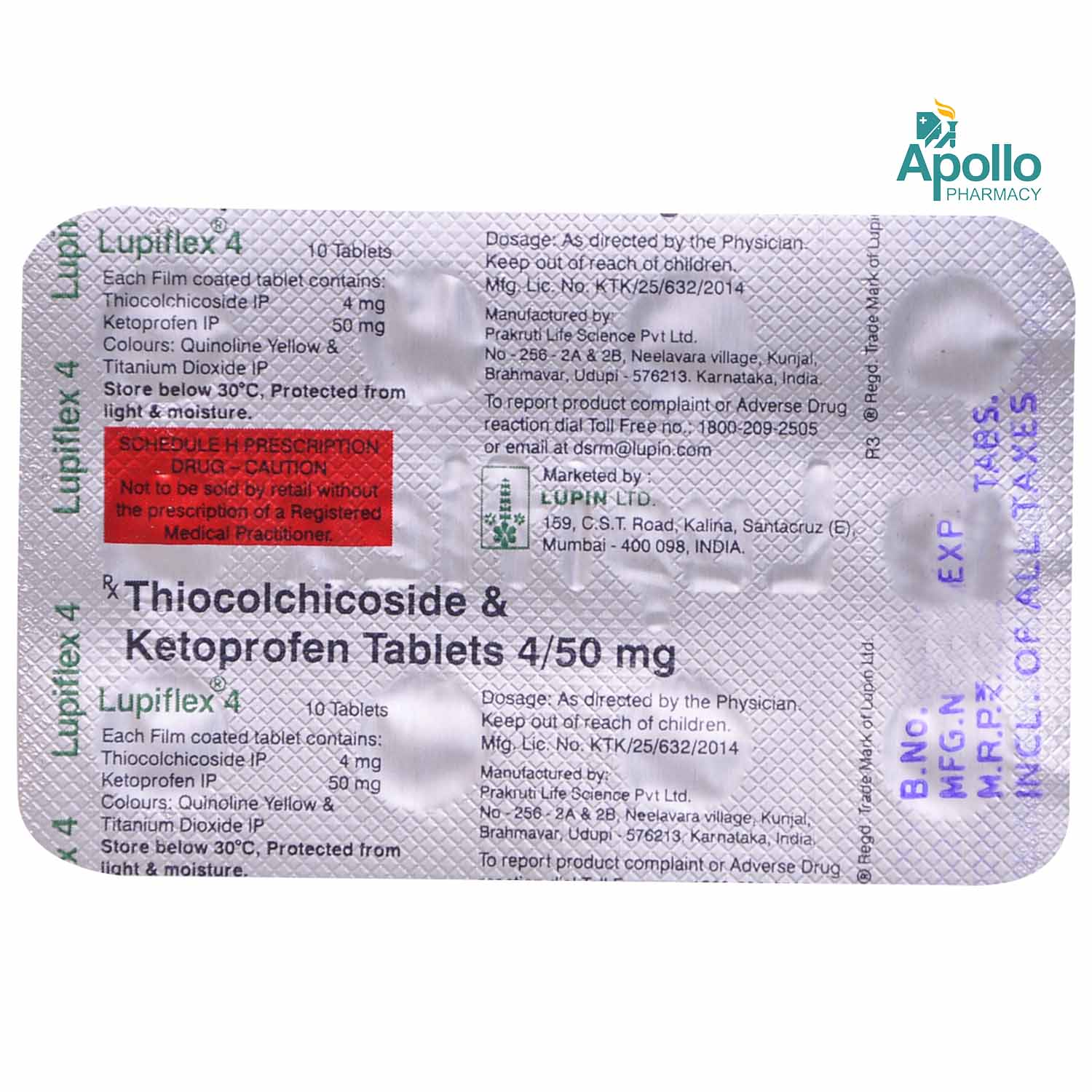Lupiflex 4 Tablet





MRP ₹225.5
(Inclusive of all Taxes)
₹33.8 Cashback (15%)
know your delivery time
Provide Delivery Location
Composition :
Manufacturer/Marketer :
Consume Type :
Expires on or after :
Return Policy :

Secure Payment

Trusted by 8 Crore Indians

Genuine Products
Therapeutic Class
FAQs
Disclaimer
Alcohol
Pregnancy
Breast Feeding
Driving
Liver
Kidney
Children
Product Substitutes
About Lupiflex 4 Tablet
Uses of Lupiflex 4 Tablet
Medicinal Benefits Mweb
Key Benefits
Directions for Use
Side Effects of Lupiflex 4 Tablet
Drug Warnings
Drug-Drug Interactions
Drug-Drug Interactions
Login/Sign Up
Coadministration of ketorolac together with Lupiflex 4 Tablet may increase the risk of side effects in the gastrointestinal tract such as inflammation, bleeding and ulcers.
How to manage the interaction:
Taking Ketorolac with Lupiflex 4 Tablet is not recommended, but it can be taken together if prescribed by a doctor. However, consult your doctor if you experience any unusual bleeding, dizziness, lightheadedness, red or black, tarry stools, coughing up or vomiting fresh or dried blood that looks like coffee grounds, severe headache, and weakness. Do not discontinue any medications without consulting a doctor.
Taking Dabigatran etexilate with Lupiflex 4 Tablet can increase the risk of bleeding leading to serious blood loss.
How to manage the interaction:
Taking Dabigatran etexilate with Lupiflex 4 Tablet together can possibly result in an interaction, but it can be taken if your doctor has advised it. However, if you experience unusual bleeding or bruising, dizziness, lightheadedness, red or black, tarry stools, coughing up or vomiting fresh or dried blood that looks like coffee grounds, severe headache, and weakness, consult the doctor. Do not stop using any medications without a doctor's advice.
Coadministration of Piroxicam with Lupiflex 4 Tablet can increase the risk of side effects such as inflammation(swelling with redness and pain), bleeding, ulceration.
How to manage the interaction:
Although there is a possible interaction between Piroxicam and Lupiflex 4 Tablet, you can take these medicines together if prescribed by a doctor. However, if you experience unusual bleeding or bruising, dizziness, lightheadedness, red or black, tarry stools, coughing up or vomiting fresh or dried blood that looks like coffee grounds, severe headache, and weakness, consult the doctor. Do not stop using any medications without talking to a doctor.
Co-administration of Ibrutinib with Lupiflex 4 Tablet can increase the risk of bleeding leading to serious blood loss.
How to manage the interaction:
Taking Ibrutinib with Lupiflex 4 Tablet together can result in an interaction, but it can be taken if a doctor has advised it. However, if you experience unusual bleeding or bruising, dizziness, lightheadedness, red or black, tarry stools, coughing up or vomiting fresh or dried blood that looks like coffee grounds, severe headache, and weakness, consult a doctor. Do not stop using any medications without a doctor's advice.
Coadministration of Lupiflex 4 Tablet and Tenofovir disoproxil can increase the risk of developing kidney problems.
How to manage the interaction:
Taking Lupiflex 4 Tablet and Tenofovir disoproxil together can lead to an interaction, but it can be taken if your doctor advises. However, if you experience any symptoms like nausea, vomiting, loss of appetite, increased or decreased urination, sudden weight gain or weight loss, shortness of breath, muscle cramps, dizziness, and irregular heart rhythm, contact your doctor immediately. Do not discontinue any medications without consulting your doctor.
Coadministration of Lupiflex 4 Tablet and Apixaban co-administration may raise the risk of bleeding.
How to manage the interaction:
Even though combining Lupiflex 4 Tablet and Apixaban may cause an interaction, it is still possible to take it if your doctor advises you to. Consult a doctor if you experience symptoms like blood in your urine or stool (or a black stool), severe bruising, prolonged nosebleeds, feeling dizzy or lightheaded, weakness or severe headache, vomiting blood or coughing up blood, heavy menstrual bleeding (in women), difficulty breathing, or chest pain. Without consulting a doctor, never stop taking any medications.
Taking Lupiflex 4 Tablet with fondaparinux can increase the risk of bleeding complications.
How to manage the interaction:
Taking Fondaparinux with Lupiflex 4 Tablet together can possibly result in an interaction, but it can be taken if your doctor has advised it. However, if you experience bleeding, severe back pain, dizziness, black or red stools, severe headache, weakness, and vomiting contact your doctor immediately. Do not stop using any medications without first talking to your doctor.
Everolimus can cause kidney issues, and taking it with Lupiflex 4 Tablet, can enhance the risk.
How to manage the interaction:
There may be a possibility of interaction between Everolimus and Lupiflex 4 Tablet, but it can be taken if prescribed by a doctor. However, if you experience nausea, vomiting, loss of appetite, increased or decreased urination, sudden weight gain or loss, fluid retention, swelling, shortness of breath, muscle cramps, tiredness, weakness, dizziness, confusion, or an irregular heart rhythm, consult a doctor. Do not stop using any medications without talking to a doctor.
Taking Lupiflex 4 Tablet with etodolac may raise the risk of gastrointestinal adverse effects (inflammation, bleeding, ulceration, and, in rare cases perforation).
How to manage the interaction:
Co-administration of Etodolac with Lupiflex 4 Tablet can result in an interaction, but it can be taken if a doctor has advised it. However, if you experience any unusual bleeding or bruising, dizziness, lightheadedness, red or black, tarry stools, coughing up or vomiting fresh or dried blood that looks like coffee grounds, a severe headache, and/or weakness, consult a doctor immediately. Do not discontinue any medications without consulting a doctor.
Using Dasatinib together with Lupiflex 4 Tablet may increase the risk of bleeding.
How to manage the interaction:
Co-administration of Dasatinib with Lupiflex 4 Tablet can result in an interaction, but it can be taken if a doctor has advised it. If you experience symptoms - like bruising, feeling dizzy or lightheaded, having red or black stools, severe headaches contact a doctor right away. Do not stop using any medications without a doctor's advice.
Drug-Food Interactions
Drug-Food Interactions
Login/Sign Up
Drug-Diseases Interactions
Drug-Diseases Interactions
Login/Sign Up
Drug-Drug Interactions Checker List
Habit Forming
Special Advise
Diet & Lifestyle Advise
All Substitutes & Brand Comparisons
RX
Out of StockThioket TH 50mg/4mg Tablet
Trans Life Sciences
₹113
(₹10.17 per unit)
49% CHEAPERRX
Out of StockThioren Tablet 10's
Albus Healthcare Pvt Ltd
₹182
(₹16.38 per unit)
19% CHEAPERRX
Out of StockChymograce-KT Tablet 10's
Stanley Healthcare Pvt Ltd
₹186.5
(₹16.79 per unit)
17% CHEAPER

Have a query?
Buy best C.n.s Drugs products by
Intas Pharmaceuticals Ltd
Sun Pharmaceutical Industries Ltd
Torrent Pharmaceuticals Ltd
Alkem Laboratories Ltd
Abbott India Ltd
Cipla Ltd
Alteus Biogenics Pvt Ltd
Micro Labs Ltd
Lupin Ltd
Ipca Laboratories Ltd
D D Pharmaceuticals Pvt Ltd
Icon Life Sciences
Mankind Pharma Pvt Ltd
Tripada Healthcare Pvt Ltd
Arinna Lifesciences Ltd
Linux Laboratories Pvt Ltd
East West Pharma India Pvt Ltd
La Renon Healthcare Pvt Ltd
Talent India Pvt Ltd
Tas Med India Pvt Ltd
Zydus Healthcare Ltd
Cnx Health Care Pvt Ltd
Eris Life Sciences Ltd
Leeford Healthcare Ltd
Emcure Pharmaceuticals Ltd
Macleods Pharmaceuticals Ltd
Sigmund Promedica
Aristo Pharmaceuticals Pvt Ltd
Dr Reddy's Laboratories Ltd
Troikaa Pharmaceuticals Ltd
Consern Pharma Ltd
Zydus Cadila
Shine Pharmaceuticals Ltd
Wockhardt Ltd
Ardent Life Sciences Pvt Ltd
Crescent Formulations Pvt Ltd
Theo Pharma Pvt Ltd
Reliance Formulation Pvt Ltd
Ikon Pharmaceuticals Pvt Ltd
Propel Healthcare
Neon Laboratories Ltd
Jagsam Pharma
Msn Laboratories Pvt Ltd
Morepen Laboratories Ltd
Pulse Pharmaceuticals
Sanofi India Ltd
Med Manor Organics Pvt Ltd
Hetero Healthcare Pvt Ltd
Novartis India Ltd
Crescent Therapeutics Ltd
Elder Pharmaceuticals Ltd
Solvate Laboratories Pvt Ltd
Akumentis Healthcare Ltd
Mova Pharmaceutical Pvt Ltd
Psyco Remedies Ltd
Tripada Lifecare Pvt Ltd
Ajanta Pharma Ltd
Cyrus Remedies Pvt Ltd
Medishri Healthcare Pvt Ltd
Cadila Healthcare Ltd
Glenmark Pharmaceuticals Ltd
Matteo Health Care Pvt Ltd
Hbc Life Sciences Pvt Ltd
Lyf Healthcare
Matias Healthcare Pvt Ltd
Mesmer Pharmaceuticals
Alembic Pharmaceuticals Ltd
Capital Pharma
Crescent Pharmaceuticals
Medopharm Pvt Ltd
Alniche Life Sciences Pvt Ltd
Kivi Labs Ltd
Talin Remedies Pvt Ltd
USV Pvt Ltd
Quince Lifesciences Pvt Ltd
Solis Pharmaceuticals
Infivis Life Care
Zuventus Healthcare Ltd
Cadila Pharmaceuticals Ltd
Pfizer Ltd
Wallace Pharmaceuticals Pvt Ltd
A N Pharmacia Laboratories Pvt Ltd
Blue Cross Laboratories Pvt Ltd
Jenburkt Pharmaceuticals Ltd
Lia Life Sciences Pvt Ltd
Mano Pharma
Medley Pharmaceuticals Ltd
Primus Remedies Pvt Ltd
FDC Ltd
Maneesh Pharmaceuticals Ltd
Apex Laboratories Pvt Ltd
Gagnant Healthcare Pvt Ltd
Ozone Pharmaceuticals Ltd
RPG Life Sciences Ltd
Strides Shasun Ltd
Unichem International
GlaxoSmithKline Pharmaceuticals Ltd
Kuresys Labs Pvt Ltd
LA Pharma
Trion Pharma India Llp


